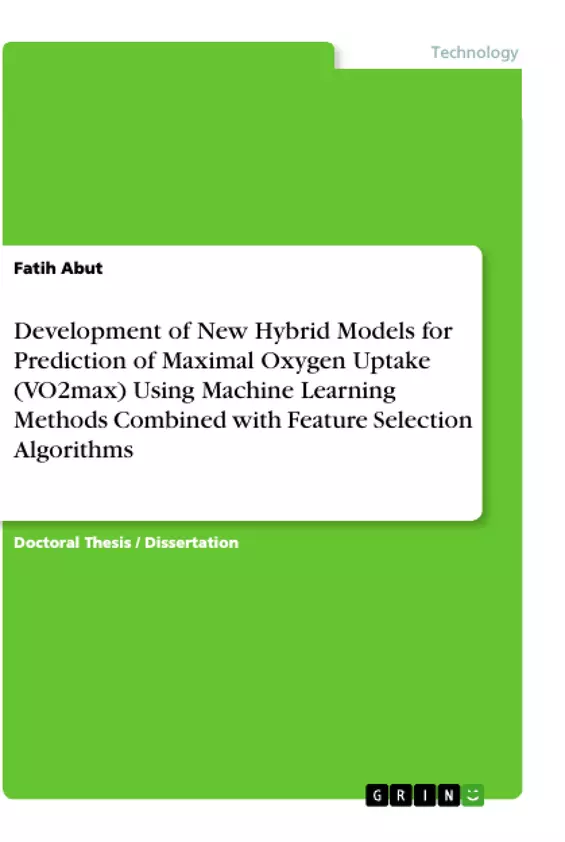The purpose of this thesis is twofold. The first purpose is to develop new hybrid feature selection-based maximal oxygen uptake (VO2max) prediction models using for the first time the double and triple combinations of maximal, submaximal and questionnaire variables. Several machine learning methods including Support Vector Machine, artificial neural network-based and tree-structured methods combined individually with three feature selectors Relief-F, minimum redundancy maximum relevance (mRMR) and maximum-likelihood feature selector (MLFS) have been applied for model development.
The second purpose is to design a new ensemble feature selector, which aggregates the consensus properties of Relief-F, mRMR and MLFS to produce more robust decisions about the set of relevantly identified VO2max predictors and to create more accurate prediction models. Using 10-fold cross validation on three different datasets, the performance of prediction models has been evaluated by calculating their multiple correlation coefficients (R’s) and root mean squared errors (RMSE’s). The results show that compared with the results of the other regular feature selection-based models in literature, the reported values of R and RMSE of the hybrid models in this thesis are considerably more accurate. Furthermore, prediction models based on the proposed ensemble feature selector outperform the models created by individually using the Relief-F, mRMR or MLFS, achieving similar or ideally up to 12.46% lower error rates on the average.
Inhaltsverzeichnis (Table of Contents)
- Abstract
- Extended Abstract
- Chapter 1: Introduction
- 1.1 Maximal Oxygen Uptake (VO2max) and its Importance
- 1.2 Methods for VO2max Measurement
- 1.3 VO2max Prediction Models
- 1.4 Motivation and Research Questions
- Chapter 2: Literature Review
- 2.1 Existing VO2max Prediction Models
- 2.1.1 Maximal VO2max Prediction Models
- 2.1.2 Submaximal VO2max Prediction Models
- 2.1.3 Questionnaire-Based VO2max Prediction Models
- 2.2 Feature Selection Methods for Machine Learning
- 2.2.1 Filter Methods
- 2.2.2 Wrapper Methods
- 2.2.3 Embedded Methods
- Chapter 3: Materials and Methods
- 3.1 Datasets
- 3.1.1 VO2max-set-1
- 3.1.2 VO2max-set-2
- 3.1.3 VO2max-set-3
- 3.2 Feature Selection Methods
- 3.2.1 Relief-F
- 3.2.2 Minimum Redundancy Maximum Relevance (mRMR)
- 3.2.3 Maximum-Likelihood Feature Selector (MLFS)
- 3.2.4 Majority Voting Feature Selector (MVFS)
- 3.3 Machine Learning Methods
- 3.3.1 Support Vector Machine (SVM)
- 3.3.2 Multilayer Feed-Forward Artificial Neural Network (MFANN)
- 3.3.3 General Regression Neural Networks (GRNN)
- 3.3.4 Radial Basis Function Neural Network (RBFNN)
- 3.3.5 Tree Boost (TB)
- 3.3.6 Decision Tree Forest (DTF)
- 3.3.7 Single Decision Tree (SDT)
- 3.4 Model Evaluation and Performance Metrics
- Chapter 4: Results
- 4.1 Feature Selection Results
- 4.2 Prediction Model Performance
- Chapter 5: Discussion
- 5.1 Contributions and Significance
- 5.2 Limitations and Future Work
Zielsetzung und Themenschwerpunkte (Objectives and Key Themes)
This thesis aims to develop novel hybrid models for predicting maximal oxygen uptake (VO2max) using machine learning methods combined with feature selection algorithms. This research explores the benefits of combining maximal, submaximal, and questionnaire variables to improve the accuracy of VO2max prediction models.
- Development of hybrid feature selection-based VO2max prediction models
- Evaluation of the effectiveness of combining different types of variables (maximal, submaximal, and questionnaire) for VO2max prediction
- Design and implementation of a novel ensemble feature selector, the Majority Voting Feature Selector (MVFS)
- Comparison of the performance of different machine learning algorithms for VO2max prediction
- Assessment of the accuracy and robustness of the proposed models using 10-fold cross-validation on multiple datasets
Zusammenfassung der Kapitel (Chapter Summaries)
Chapter 1 introduces the concept of VO2max, its significance in health and physical fitness, and the challenges associated with direct VO2max measurement. This chapter also presents the motivation behind this research and outlines the specific research questions addressed in the thesis.
Chapter 2 provides a comprehensive review of existing VO2max prediction models based on maximal, submaximal, and questionnaire variables. It also discusses various feature selection methods commonly used in machine learning, exploring their advantages and limitations.
Chapter 3 details the materials and methods used in this research. This includes a description of the three datasets utilized for model development, the feature selection algorithms employed, and the machine learning methods applied to construct the VO2max prediction models. It also elaborates on the model evaluation techniques and performance metrics employed.
Chapter 4 presents the results of the feature selection process and the performance evaluation of the developed prediction models. It analyzes the selected features for each dataset and compares the accuracy and robustness of the proposed hybrid models with existing methods.
Chapter 5 discusses the contributions and significance of this research, highlighting the novel aspects of the developed hybrid models and their potential impact on the field of VO2max prediction. This chapter also acknowledges the limitations of the study and suggests potential directions for future research.
Schlüsselwörter (Keywords)
This thesis focuses on the application of machine learning methods and feature selection algorithms to predict maximal oxygen uptake (VO2max). Key topics include hybrid models, feature selection, Relief-F, mRMR, MLFS, MVFS, Support Vector Machine (SVM), artificial neural networks, and prediction accuracy.
- Citar trabajo
- Fatih Abut (Autor), 2017, Development of New Hybrid Models for Prediction of Maximal Oxygen Uptake (VO2max) Using Machine Learning Methods Combined with Feature Selection Algorithms, Múnich, GRIN Verlag, https://www.grin.com/document/1156463



